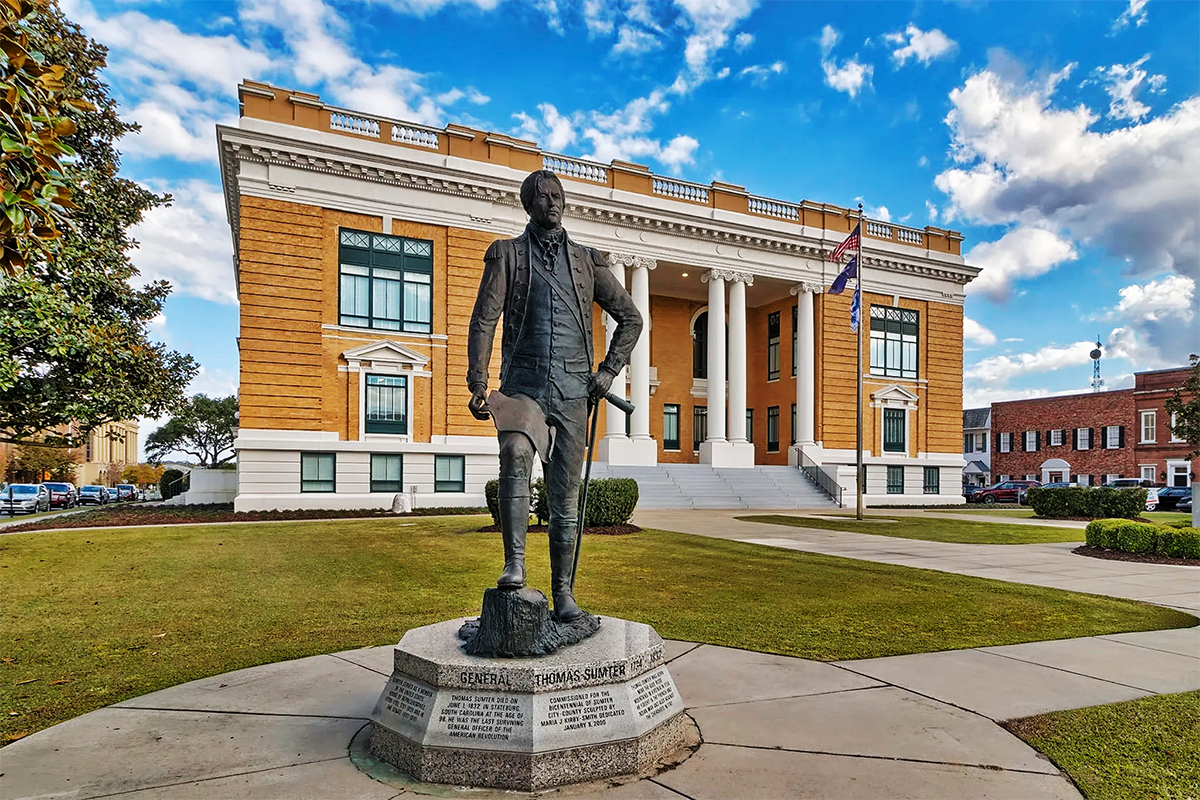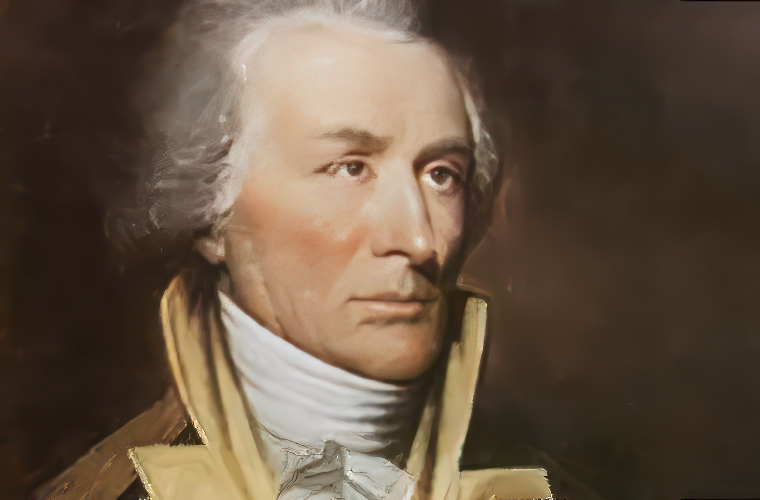Thomas Sumter was born on 14 August 1734 near Charlottesville, Virginia. He served as a sergeant of Virginia troops in the 1761 campaign against the Cherokees. At the end, of that campaign, he escorted a troop of Cherokee leaders to England and back. On their return to the Cherokee nation, Sumter fought a French officer, the Baron des Jonnes, whom he found attempting to recruit the Cherokee. He emerged victorious and took the baron prisoner.
Sumter was jailed for debt in Staunton, Virginia, in 1765, but he escaped and fled to South Carolina. There he opened a store near Eutaw Springs and married a wealthy widow, Mary Cantey Jameson, in 1767. By 1775 he owned thousands of acres, mills, and many slaves. Sumter was elected to the first and second provincial congresses, which became the new state assembly in 1776. He also captained a company of mounted rangers under Colonel Richard Richardson, defeating a group of Loyalists in the “snow campaign” of December 1775 (so-called because of the record fifteen inches of snow that had just fallen).
The following year he was promoted to lieutenant colonel of the Second (later Sixth) Rifle Regiment which formed part of the defense of Charleston against General Henry Clinton’s attack in July 1776. Sumter’s regiment became part of the Continental army, participating in some minor skirmishes against the Cherokee and in limited military operations in South Carolina and Georgia. In 1778 Sumter joined General Robert Howe in planning the aborted invasion of Florida but contracted malaria and resigned on 19 September 1778. When parts of his plantation were burned and his slaves were liberated by Captain Charles Campbell of Banastre Tarleton’s Legion in 1780, Sumter headed for the Patriot stronghold west of the Catawba River and started raising volunteers. He was soon joined by a number of other officers seeking to resist the successful British forces.

Sumter’s partisans struck first at Williamson’s Plantation, on 12 July 1780, gaining a victory that brought him more volunteers. Repulsed at Rocky Mount on 1 August, Sumter went on to success at Hanging Rock on 6 August. His lack of strategic sense first showed itself in the Camden campaign. On 18 August, after General Horatio Gates accepted his request for reinforcement and just before the main army advanced to defeat Camden, Sumter was badly beaten by Tarleton at Fishing Creek. He soon resumed operations, however, and on 6 October was named senior brigadier general of the South Carolina militia. Although the action at Fishdam Ford, on 9 November, was a draw, he foiled an attempt by the notorious Major James Wemyss to annihilate him and inspired a Patriot uprising that panicked Cornwallis. Sumter fought Tarleton to a bloody standstill at Blackstock on 20 November but was badly wounded.
By this time Sumter was known as “The Carolina Gamecock,” for the cock’s feather he wore in his hat. Sending word for Francis Marion to join forces with him, Sumter started down the Congaree River on 16 February 1781 in hopes of inspiring more enlistments as he made his way to the Santee River. He would support this operation logistically by capturing the enemy base of Fort Granby. Marion knew that the British were reinforcing the posts along their line of communications and was pessimistic about the success of Sumter’s strategy, but being the junior brigadier general, he prepared to join Sumter.
Sumter launched his attack on Fort Granby before dawn on 19 February, before Marion could arrive. The next day he had to retreat as Colonel Welbore Doyle’s New York Volunteers approached to relieve the garrison. The partisans moved 35 miles downriver and surprised the post at Belleville, but had to withdraw when enemy forces approached from Camden. On 28 February he launched an attack against Fort Watson without having properly reconnoitered the outpost and therefore suffered a costly repulse.
When he learned that Colonel John Watson was preparing to attack him with overwhelming force, Sumter moved to his plantation to pick up his paralytic wife and young son and started withdrawing northward. After moving some 40 miles to the Bradley Plantation, between the Black and Lynches rivers, he waited until 6 March before giving up hope of seeing Marion and then continued his retreat northward. On that same day, Major Thomas Fraser’s Loyal South Carolina Regiment attacked Sumter’s force, the partisans escaping with the loss of ten killed and about forty wounded. His own ill-advised campaign was over, but as Nathanael Greene’s army approached he ignored the latter’s requests to join him in an attack on Francis Rawdon’s principal post.
Sumter wanted to fight his own little war. When Greene needed his support at Hobkirk’s Hill, Sumter struck at Fort Granby, instead. He broke off that attack, however, to capture Orangeburg on 11 May, and then threatened to resign from the army because Henry Lee had taken Granby while he was otherwise occupied. Greene placated Sumter, who then came up with his controversial plan of raising troops by “Sumter’s law”: to recruit dependable mounted militia for ten months, Sumter proposed paying them in plunder taken from Loyalists in a sort of “pay as you go” scheme. He succeeded in assembling men but touched off a renewed wave of vicious civil war and earned a disreputable reputation that dogged him to the grave. When he finally moved south to support Greene, his strategic blunders contributed to the American failure at Ninety-Six.
Sumter then got Marion and Lee put under his command and launched a campaign that ended in the mismanaged attack at Quinby Bridge on 17 July. On the 25th he sent a force to plunder Loyalists in Georgetown. The British retaliated by virtually destroying Georgetown on 2 August. Perceiving Sumter’s policies as counterproductive, Governor John Rutledge, who had just arrived to restore a civil government in South Carolina, issued a proclamation terminating “Sumter’s law” by prohibiting plundering.
This action also ended Sumter’s military career. Bothered by his wound, exhausted by his campaigns, and with his name “almost universally odious” (as Henry Lee put it), Sumter retired to his plantation. Sumter was elected state senator and sat in the assembly that met on 8 January 1782 at Jacksonboro. He resigned from his military commission the next month.
After the war, he was given the thanks of the South Carolina senate and a gold medal. Sumter served many terms in the South Carolina statehouse. After an investigation into his use of “Sumter’s law,” Sumter was exonerated, and the legislatures of North and South Carolina forbade state courts to entertain damage suits connected with this matter. He founded Stateburg, South Carolina, which he attempted to have made the state capital, without success. An anti-federalist, he voted against the Constitution in the South Carolina ratifying convention. Elected to the First Congress, he worked to limit federal powers. Suspected of speculation in government paper, he was defeated for re-election in 1793 but returned to Congress in 1796 as an adherent of Thomas Jefferson.
He served in the House of Representatives until elected to the Senate in December 1801 and resigned from Congress in December 1810. For the next 22 years, he was harried by litigation and creditors. In 1827 the South Carolina legislature granted him a lifetime moratorium for his debt to the state bank. He lived to be 98, the oldest surviving general of the war, dying on 1 June 1832.

